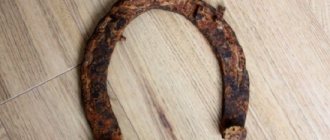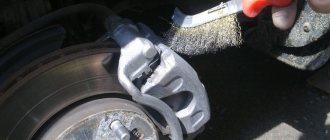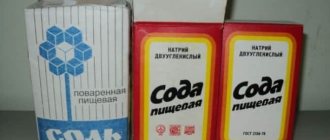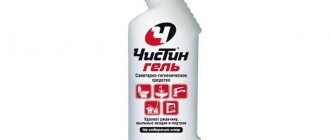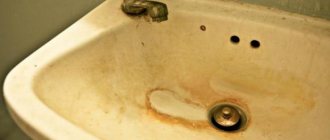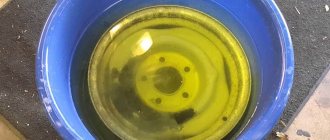Rust stains on ceramic or earthenware plumbing do not always occur, but they are very noticeable. Of course, it is simply unrealistic to wash off such streaks with water and a brush, so I want to tell you how to get rid of rust in the toilet using folk remedies or household chemicals. I will say right away that you should not delay this, since as the layer of corrosion thickens, the cleaning process becomes much more complicated and some products lose their effectiveness.
Why does dirt form in the toilet?
Most often, a yellow coating appears on the surface of the walls of plumbing fixtures, which gradually turns into noticeable lime deposits. They are collected in those places where water flows into the toilet. A predisposing factor to the accumulation of limestone is water saturated with salts. In addition, this process is also influenced by the frequency of use of plumbing fixtures - this means that the less often residents use the drain, the faster deposits accumulate.
Rusty stains
It is not uncommon for noticeable stones to accumulate on the walls of the toilet. Only in this case, the quality of the water does not affect the process, because salts are contained in human urine, which means they enter there every day. This problem often occurs when installing plumbing fixtures with a rough surface. Plaque is characterized by an unpleasant odor, which only intensifies over time, because urinary stones are a favorable environment for the spread of microorganisms.
How to clean a toilet from urinary stone? Read in detail in a special article.
The appearance of the toilet is also spoiled by traces of rust, which also appear in places where water moves from the barrel. There are several reasons for this problem:
- the water contains metals;
- the apartment has an old water supply system with rusted metal pipes;
- a broken drain barrel, causing water to constantly leak;
- presence of manufacturing defects on the walls of the toilet.
It is necessary to constantly maintain the cleanliness of plumbing fixtures
Electrolyte - removing stubborn stains
If the walls of the plumbing have lost their whiteness, an electrolyte will help correct the situation. The substance, which is an essential component of a car battery, contains sulfuric acid. It actively interacts with oxides and salts.
Since the electrolyte is poisonous, do not neglect protective accessories during cleaning. Not only will you need gloves and a face mask, but also a respirator. It is necessary to protect the respiratory system not only because of the unpleasant odor, but also because inhaling the smallest particles of electrolyte is dangerous to health.
The composition applied to contaminated areas instantly triggers a chemical reaction. The electrolyte is washed off after 15 minutes; if necessary, rust residues are removed with a brush.
Since the cleaning composition is toxic, it is recommended to use it only if the layer of rusty deposits is very large and there is no money to purchase high-quality household chemicals. You should not use electrolyte if the toilet is connected to the sewerage system with polypropylene pipes.
Toilet cleaning methods and preparation
When there is too much dirt on the walls of the toilet, it will take a lot of effort to remove them. For such purposes, various household chemicals, acids, and gentle folk remedies are used. The choice of one method or another depends on the degree of contamination of the plumbing.
Note! You should use various metal meshes to clean the toilet with caution, because they leave mechanical damage on the surface, where dirt subsequently collects.
Rigid metal mesh will only damage the coating
Before you begin the toilet cleaning procedure, you need to prepare:
- The first thing you should do is stock up on rubber gloves to protect your hands, because any alkaline products or acids have a negative effect on the skin.
- Then you will need to scoop out the water from the neck of the toilet. To facilitate this process, you can use a plunger or a large syringe.
Wear gloves when working with any toilet cleaning products.
Three main enemies of toilet cleanliness
A sparkling clean toilet is a source of pride for any housewife. But, unfortunately, he doesn’t remain that way for long. A short time after cleaning, unpleasant red stains may appear on the surface of the equipment.
These are streaks of rust, a product of the oxidation of iron or other metal alloys. It seems that there is nowhere for it to come from in the toilet, which is made of ceramic with plastic parts.
However, there are several reasons for the appearance of rust. The first is the deplorable state of engineering communications. Old lines were made of non-galvanized metal, which inevitably corrodes over time.
Oxide particles fall into the water, which leaves a rusty mark on the surface of the equipment.
Rust stains are very difficult to remove from a toilet bowl without the use of special cleaning products found in the household or purchased in a store.
Frequent causes of rust stains also include iron-enriched water entering the water supply and leakage of liquid from the tank.
In addition to rust, limescale deposits leave marks on the surface of the toilet. The intensity of its formation depends on the composition of the water used in the water supply system.
It necessarily contains various mineral compounds that settle on the walls of the toilet and form an unpleasant, hard grayish coating. The more lime compounds in the water, the faster plaque appears.
And the third “enemy” of cleanliness of plumbing equipment is urinary stone. It is formed similarly to limescale, the only difference being its composition. The stone is formed from minerals contained in human urine.
When the toilet is used carelessly or when flushed irregularly, urine residues linger on the surface of the toilet, forming a hard coating of an unpleasant brownish-yellow color.
Ideally, you should use a special product for each type of toilet contamination; this makes it easier to deal with them. But universal solutions can also be useful
Thus, there are three main types of toilet contamination. They differ significantly from each other in their chemical composition; accordingly, it will be possible to get rid of them using different means. Although there are universal methods of cleansing that will help in all cases.
I would like to note one more point. All types of contaminants first begin to be deposited where the surface of the toilet bowl has become rough or microcracks have appeared.
Most often, ceramics lose their smoothness after contact with overly hot liquids or objects. Sudden temperature changes are also extremely harmful to the toilet, as microcracks may appear as a result.
You need to know that budget models of plumbing fixtures are made from ordinary sanitary ware with fairly high porosity. This material is prone to the accumulation of contaminants. It is better to purchase equipment made from sanitary porcelain, which has an increased surface smoothness.
Folk remedies for rust removal
If the pollution is not too noticeable, then you can deal with it using folk remedies, which every housewife can find. Their main advantage is that such components do not destroy the integrity of plastic water pipes. In addition, you can purchase components for cleaning the toilet according to “folk recipes” on a very budget and in any store near your home.
Citric acid: step-by-step instructions
You will need to prepare 2-3 packets of citric acid, as well as cleaning equipment: brushes, brush.
Step one: first you need to scoop out all the water from the toilet and pour citric acid into it.
The acid should cover all contaminants inside the plumbing fixtures and under the rim in a dense layer
Step two: now you need to close the toilet lid and leave it for 3.5 hours. If there are a lot of deposits and traces of rust, the holding time will have to be increased.
Upon completion of the procedure, it is necessary to rinse off the acid, and then remove any remaining dirt with a brush.
Citric acid with vinegar: step-by-step instructions
You will need to use two packets of citric acid, a third of a glass of vinegar and various tools for cleaning the toilet.
Step one: you need to pour citric acid into a dry toilet bowl as in the previous method. Then apply vinegar on top of the dirt from a spray bottle, which will react with the acid (the powder will hiss and foam).
This mixture must be left on the surface of the toilet for about four hours.
Step two: when the plaque softens, it can be easily removed with a brush
Clean the structure with a brush
Vinegar and iodine: step-by-step instructions
Step one: first of all, you need to pour vinegar into a container and burn it to about 45 degrees, you also need to add a few drops of iodine. Then the mixture must be poured into a dry toilet.
The shade of the liquid should not be dark
Step two: Next, you should take any rag (afterwards you will have to throw it away), moisten it in the bite solution and apply it to particularly contaminated areas. The toilet should be left in this form for 4.5 hours.
After a while, you will need to remove the rags and rinse the toilet with water to remove plaque.
Soda and vinegar: step-by-step instructions
There are two effective options for cleaning the toilet using baking soda and vinegar. In order to choose the right one, you need to consider them in more detail.
Option #1
You will need to prepare one glass of vinegar, a couple of tablespoons of baking soda and any container that is suitable for heating on the stove. In addition, you will need brushes, sponges, and a brush.
Step one: you need to put a container of vinegar on the stove and then boil it. Add baking soda to hot vinegar
Regular table vinegar is suitable for preparing the mixture.
Step two: before this mixture has cooled, you need to pour the dirt into it.
After a few hours, you need to rinse the toilet with clean water.
Option No. 2
During the cleaning process you will need vinegar, baking soda, a spray bottle, gloves and sponges.
Step one: First, you need to mix baking soda with water to form a thick paste.
Apply this composition to traces of dirt and rust and leave for 50-60 minutes.
Step two: now you should pour the vinegar into a spray bottle and apply it to the soda.
When this mixture stops fizzing, you will need to flush the toilet.
Step Three: The plumbing will need to be washed again with soapy water.
You can use any liquid soap
Baking and soda ash
It is necessary to prepare baking soda and soda ash in equal quantities, as well as gloves and brushes.
You will need to pour two types of soda into the toilet and leave for about 9-10 hours (it is recommended to do this at night). In the morning, all that remains is to rinse the plumbing with water. It is recommended to repeat this procedure several times.
Baking and soda ash
Other folk methods of combating pollution
There are other ways to deal with rust using improvised means:
- Sparkling water. On the Internet you can find many recipes for cleaning plumbing fixtures with the Coca-Cola drink. Indeed, soda can dissolve any deposits in 7-8 hours. To enhance the effect, you will need to pour vinegar or a packet of citric acid into the toilet. On average, about 3 liters of drink are required.
- Toothpaste. This product can be used for both internal and external cleaning of the toilet. It is recommended to use an old toothbrush (in hard-to-reach places) and a brush as a cleaning device. However, this method is only effective if there are minimal deposits.
- Dentifrice. This is another effective and affordable remedy for the population. It is necessary to pour a package of tooth powder into the toilet, and then thoroughly clean it with a brush, then rinse with water. The advantage of the product is that after the procedure a pleasant mint aroma remains.
Any carbonated drink can be used to clean the toilet.
Dentifrice
Industrial production assistants
Toilet bowl cleaners are available in the form of solutions, powders or gels. The last category is considered the most convenient due to its thick consistency and specially shaped bottle. It allows you to clean dirt in hard-to-reach places.
All products have almost the same composition, the effect of surfactants is enhanced by the presence of:
- acids that remove rust;
- alkali, which breaks down organic contaminants and fat;
- chlorine, which has an antimicrobial effect and the ability to neutralize odors.
The choice depends on the preferences of the housewife, the characteristics of surfaces and types of contamination. Read more about industrial products for cleaning toilet bowls from rust here.
Alkaline
Caustic soda (lye) removes all types of contaminants well . Cleaning is carried out without effort and damage to surfaces.
Recommended use:
- Domestos is a gel that will deal with rust on the surface of the toilet in 10 minutes, refresh and disinfect. For old stains, it is recommended to leave the product overnight. Price from 180 to 240 rubles per 1 liter.
- Lima Professional - whitening gel for the toilet, removes all types of dirt, destroys odors and microorganisms. Price from 120 to 180 rubles per 1 liter.
- Chistin 3 in 1 for plumbing is an inexpensive gel for cleaning and disinfecting ceramics, effective in combating corrosion products, and has antibacterial properties. Price from 70 to 130 rubles per 750 g.
This group should not be mixed with gels containing acids. The two active substances neutralize each other’s effects and do not give a positive result.
Abrasive
The category includes powders, pastes, suspensions that contain grinding particles and remove contaminants using mechanical action. Suitable for cleaning toilets:
Pemolux Soda is a cleaning powder to combat stains with a refreshing effect. Price from 40 to 60 rubles per 480 g.- Chistin lemon is a universal powder for cleaning surfaces with a refreshing scent. Price from 35 to 60 rubles per 400 g.
- Comet - a powder containing chlorine, with an antibacterial effect, removes all types of contamination from the surface of plumbing fixtures. Price from 60 to 100 rubles per 475 g.
Abrasives act more slowly and require effort. Another disadvantage is that they can leave microcracks on the surface, in which deposits will accumulate more quickly.
Acid-containing
Acid-based household chemicals give good results, but require caution when working due to their aggressive composition. The most popular:
- Cillit Bang is a thick hydrochloric acid-based gel in a convenient package with a thin spout. Successfully fights against any contamination of the toilet thanks to its aggressive composition. Price from 180 to 250 rubles per 750 ml.
- Toilet duck 5 in 1 – gel containing hydrochloric acid in a convenient bottle, childproof cap. Removes rust from the surface, disinfects, refreshes. Price from 120 to 200 rubles per 0.5 liter.
- Comet is a caustic gel, the main active ingredient is sulfuric acid and copes with any contaminants. Economical and effective, retains results for a long time. Price from 100 to 180 rubles per 450 ml.
It is necessary to work with the listed products with gloves to avoid damage and dehydration of the skin.
Alkaline products
Alkaline-based products are available in gel form; they have a high pH level, which allows them to quickly remove stains.
The most popular manufacturers of alkaline cleaning products:
- Bios;
- Sif;
- Baxix;
- Domestos;
- DeLaval.
Alkaline products
All these products have similar instructions for use:
- Remove water from the toilet.
- Apply the product generously along the inner walls and on the rim.
- Bid my time. The duration of action of such products ranges from 5 to 30 minutes.
- Then you will need to wash off the remaining product along with the dirt.
Note! It is not always possible to cope with rust from the first application, so such actions will have to be repeated several times.
How to choose the right product?
If you want minimal physical and time costs, you need to buy products that do not require additional treatment of contamination. These are:
- Cillit;
- Toilet duckling;
- Domestos.
If you need to save your family budget, choose products from domestic manufacturers - Sanox or Sanita.
To keep your plumbing fixtures fresh and white for as long as possible, use Comet - it has a prolonged effect.
If the bathroom you are cleaning needs a good anti-rust cleaner, then it is better to buy Sanita or Domestos.
Also, when choosing which product is better to buy, you need to pay attention to:
- constituent components;
- specifics of use;
- security measures.
Acids and acid-containing products
If after all the above manipulations the rust and urinary stones remain in place, then it is recommended to try strong acid-based products. It should be remembered that they are unsafe - if aggressive cleaning agents are used incorrectly, you can not only ruin your plumbing, but also cause harm to your health.
As additional protection, in addition to gloves, you will need a respirator and special glasses. Otherwise, you can get a burn to the respiratory tract or mucous membrane of the eyes.
Table 1. Acids against rust and dirt
| View, illustration | Description |
| Phosphoric acid (6%) | This acid quickly dissolves traces of limescale, rust and urinary stones. At the same time, it does not damage plastic pipes. For the cleaning procedure you will need no more than 130 grams of product, which should be left there for no more than 20 minutes. After which you will need to thoroughly wash the plumbing with water and soap. |
| Oxalic acid | This is a very caustic product that emits vapors that are hazardous to human health. It can be found on sale in the form of a light powder. It is necessary to apply oxalic acid pointwise to traces of rust (if desired, you can immediately dilute it with water). After that, the toilet must be left for 60 minutes, and then rinsed with water several times. |
| Hydrochloric acid (35%) | This is also a caustic agent that, in addition to contaminants, corrodes rubber and plastic. Therefore, you should not use hydrochloric acid in the presence of plastic pipes. In this case, you should not dry the toilet before cleaning it. You need to sleep no more than 130 grams of acid at a time. Its exposure time is about 20 minutes, after which the toilet should be rinsed several times with water. It is advisable to work with hydrochloric acid in a room where there is a good ventilation system. |
| Battery electrolyte | The main component of the electrolyte is sulfuric acid, which belongs to the category of dangerous toxic chemicals, so such a product should be used carefully. It is also not suitable for plastic sewer pipes. As with the previous method, you will need to pour about 130 grams of electrolyte into the toilet. This must be done carefully so as not to affect the plastic elements of the plumbing. Upon completion of the procedure, you should rinse the toilet with clean water and soap. |
Household products based on acids:
- "Silit Bang". A liquid product that, when sprayed, turns into a thick foam. Its action time does not exceed five minutes, it effectively copes with rusty stains.
- "Sanfor". This product allows you to clean the surface of plumbing fixtures from rust and eliminates pathogenic microorganisms.
The advantages of these liquid cleaning products are that they do not scratch the finish of plumbing fixtures and are economical to use.
Advice from professionals
In pursuit of perfect cleanliness, housewives should not forget about their own safety. The aggressive composition of household chemicals requires compliance with the following rules:
before cleaning the toilet, you must wear rubber gloves that will protect the skin of your hands from contact with chemicals and microorganisms;- use an oilcloth or plastic apron, a respirator to protect clothing and the respiratory tract;
- when working with products that have a strong odor, emit gas or chlorine, it is necessary to ensure an influx of fresh air into the room;
- you need to start by removing water from the tank; a ladle with a long handle is suitable for this - on a dry surface, components that destroy contaminants work better;
- If the cleaning solution comes into contact with the skin or mucous membranes, they should be washed immediately.
During this process, you should not bend low over the toilet bowl to avoid getting the solution in your face and eyes.
Abrasive agents against rust and plaque
Such products have the same properties as acids. They have a budget price and quickly cope with even stubborn stains. However, you should not use them too often or intensively, otherwise you may damage the toilet's coating.
Table 2. Popular toilet bowl cleaners with abrasive particles
| View, illustration | Description |
| Pemolux | This product copes even with old stains and a dense layer of plaque. Its main advantage is the absence of aggressive alkaline components. After using the product, there are no smudges left on the surface, and no pungent odor is released. |
| Sarma | A popular cleaning product that removes rust and cleans plumbing fixtures to a shine. Moreover, this cleaning powder effectively eliminates any bacteria. In particularly contaminated areas it should be kept for at least 25 minutes. |
| Sanita "Anti-rust" | This is a fast-acting product that turns into foam when used. Any dirt, including yellow stains, disappears in ten minutes. |
Prices for popular cleaning products for plumbing and pipes
Plumbing and pipe cleaners
Cleaning products with abrasives
Compositions of this type necessarily contain abrasives. These are very small, but sharp and hard particles, with the help of which mechanical surface treatment is carried out. Abrasives literally peel away dirt, thereby removing it from the surface. They are added in different quantities to cleaning products.
In any case, it is not advisable to use such mixtures on ceramics. This is especially true for sanitary porcelain. Abrasives leave marks similar to scratches on a smooth surface. Over time, more and more of them accumulate, the bowl becomes rough, literally “attracting” dirt.
Powders with abrasives cost very little, so they are very popular. However, you need to remember that solid particles spoil the surface of plumbing fixtures
If you still want to use cleaning products of this type, you should read the instructions on the can. Most often, in addition to abrasives, they contain some kind of bleach. Therefore, most manufacturers advise using their products in this way.
The powder is applied to a sponge moistened with water or directly to the bowl, after which it is intensively rubbed into the surface. Then you should leave the product for a while so that it “works” effectively. Then rub thoroughly with a sponge again and rinse with water.
Using bleach against rust
The well-known “Whiteness” or any other chlorine-based product quickly copes with urinary stones, plaque and rust. For best results, it is recommended to fill the toilet with bleach for 10-12 hours (at night), and then rinse thoroughly with a brush and clean water.
If desired, you can pre-rinse the plumbing with an alkaline solution, and only then use chlorine. Just remember that alkali and “Whiteness” react, so your face will also have to be protected with a respirator from harmful fumes.
“Whiteness” is a rust remover that has been proven over the years
How to remove limescale?
Limescale deposits most often form in places with high water hardness. To get rid of it, use a plunger to extract water, fill the bowl with washing gels, leave for a couple of hours and clean with a brush.
In more complex situations, drastic methods are needed, which may require:
- hard brush;
- gloves;
- vinegar;
- iodine;
- baking soda;
- lemon acid;
- white.
The above method using vinegar and soda or citric acid helps greatly against limescale deposits. Other methods include:
- Application of whiteness. The algorithm is simple: first pump out the water, then fill a bottle of this chemical overnight, and wash it off with warm water in the morning. If the effect is insufficient, these steps are repeated.
- Removal with oxalic acid, but when working with it it is recommended to follow all the precautions specified in the instructions. It is allowed to work with this powder only with rubber gloves. It is applied to a damp cloth and then the plaque formations are wiped away. You will need to leave it for about an hour, and then the sanitary ware needs to be washed thoroughly.
- Coca Cola. Fill the bowl with it, leave it for several hours, and then remove the deposits with a brush.
- Iodine monochloride can be purchased at any veterinary pharmacy. They fill it with dirt and wash it off after a couple of minutes. It is not recommended if the house has cast iron or aluminum pipes.
Cleaning company services
Long-term stains and old rust marks are difficult to deal with at home, so many housewives prefer to use the services of specialists. They have special equipment and a full arsenal of all devices and chemicals. The only downside is that such a service has a high cost.
However, turning to cleaning specialists for help has clear advantages. Firstly, you won’t have to waste time doing less than pleasant work. Secondly, people with respiratory problems, asthmatics and allergy sufferers, in principle, should not have contact with caustic household chemicals, and it would be more logical for each person to refuse to try to wash the plumbing on their own if they are protecting their health.
The company’s specialists will cope with pollution of any complexity
Mistakes in caring for plumbing fixtures
To clean the toilet, it is not recommended to use soft sponges that are intended for washing dishes, because such a structure is an excellent environment for the accumulation of pathogens. Therefore, if you still had to use such a sponge, then after completing the procedure it should be disposed of.
Special long-handled devices are sold for plumbing maintenance.
If a dense layer of urinary stones and noticeable rust stains do not accumulate on the surface of the toilet, then it is not recommended to overuse cleaning products based on strong alkali or acids, because such components gradually destroy the coating.
Features of cleaning the tank
Video - Cleaning the toilet tank
Preventing rust in the toilet
With good care of your plumbing, the appearance of rust can, in principle, be prevented, and then you won’t have to waste effort cleaning the toilet from yellow plaque:
- It is necessary to take the time to clean your plumbing regularly, at least once a week, using alkaline or chlorine-containing products.
- It is necessary to monitor the serviceability of the toilet and carry out minor repairs on time. If water leaks even a little from the tank, yellow stripes on the walls of the plumbing will appear much faster, and it will not be possible to completely remove the rust from the toilet even with the help of strong means.
- The condition of the toilet is influenced by the quality of tap water. If the water is too hard and mixed with rust from the pipes, then a yellow coating on the walls of the plumbing will appear faster. In addition, low-quality water often leads to breakdowns of the drainage system. You can solve the problem if you put special tablets in the toilet tank that help clean and soften the water.
- Rust forms faster in the toilet if the water pipes have not been replaced for too long and are rusty. It is recommended to replace old pipes; this will not only make it easier to care for your plumbing and help you clean it faster, but will also help you avoid accidents.
When using the toilet every day, it is necessary to keep it clean with a brush. You should not pour leftover food and fatty broths down the drain; all this leads to the formation of a thin greasy film on the walls of the plumbing. In this case, rust occurs faster. If the toilet is still used to dispose of food waste, then immediately after draining the remaining food, it must be cleaned with a brush.
Preventive actions
Of course, there are a large number of means to combat traces of rust, but in practice it is recommended to avoid such problems so as not to face the need for serious cleaning. Here are the rules to follow to ensure that the toilet always looks presentable:
- Clean the toilet every day with an organic product that does not contain alkali.
- Disinfect plumbing fixtures weekly with bleach.
- Use strong chemicals to clean contaminants at least once every 30 days.
- Check the pipes periodically - if they are rusty on the outside and inside, you will need to replace them with plastic ones.
- Treat bacteria under the toilet rim.
- Quite often, lime deposits appear in the presence of contaminated tap water. Installing special filters in the system, which will have to be changed from time to time, will help correct this problem.
It is necessary to periodically clean the toilet from plaque and rusty stains.
When choosing a toilet, it is recommended to choose products made of porcelain - this material has a smooth structure, which means it does not retain dirt and stones.
Prices for toilets, urinals, bidets
Toilets, urinals, bidets
How to prevent rust stains
It will not be possible to get rid of the need to clean the toilet from rust if the house has old metal pipes. But you can significantly reduce the amount of deposits by using these little tricks:
- When purchasing plumbing fixtures, give preference to models that have a water-repellent coating.
- If the tank is leaking, repair it immediately.
- The problem of deposits due to poor quality water can be solved using a filter or special products for the tank (tablets or powders) that neutralize rust and other deposits.
- Reduce the amount of water used by adjusting the tank.
- Remove rust immediately after it appears; fresh stains are much easier to deal with.
By following these recommendations, you can keep your toilet in perfect condition.

